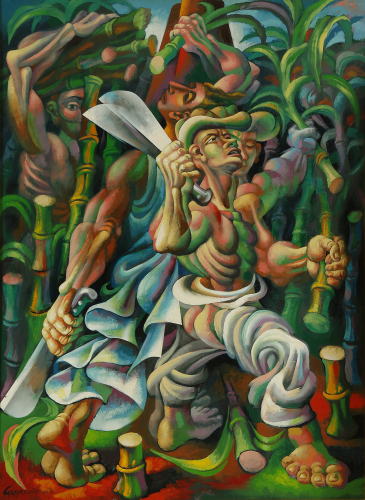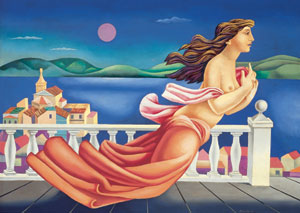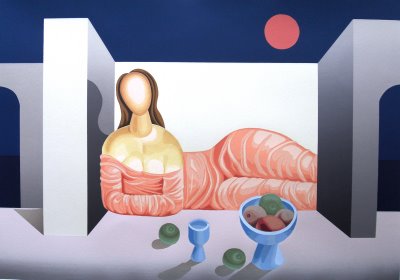Mario Carreño, the painter we ignore
By Roberto Mendez Martinez

HAVANA TIMES, July 8 (IPS) – Cuban painter Mario Carreño, who died a decade ago in Chile, has returned into the news. His work “Fuego en el batey” (Fire in the sugar mill village) was recently auctioned off at Christie’s New York Latin American Art Evening for the astronomical sum of US $2.18 million, probably the highest price paid in history for a piece by a Cuban artist.
At the end of the 1990s, this same gallery had auctioned off one of the artist’s other pieces, “El arlequín desollado”, for $442,500. At that time is was thought that this sum would be difficult to surpass by Mario or any other creator from the island.
“Fuego en el batey” was painted “a la duco” in Havana in 1943, that is to say, with automobile paint. The work appeared to have been lost for half a century, though in fact it was in a private collection in Long Island, New York. As is usual in these stories, the painter had sold it for an infinitely smaller figure.
Carreño is practically an unknown figure in Cuba, although he is an artist of importance abroad. He was born June 24, 1913 at 110 San Francisco Street, in the Vibora neighborhood of Havana, from where he began an eventful and absorbing life. His father, a small ruined Spanish merchant, was a dedicated music lover who required each of his children to study a musical instrument.
Mario, the youngest of 10 siblings, was tapped to study violin, but was freed from that torture when he won a drawing competition sponsored by the newspaper El Mundo in 1922. Some of those who commented on that debuting work believed they had found influences of Toulouse-Lautrec in it, an artist about whom the adolescent did not have at least possible idea.
Carreño took some classes with academic Antonio Rodriguez Morey and succeeded in having the San Alejandro Academy open its doors to him when he was only 12, in 1925. The boy learned very quickly in that large somber house on Dragones Street and left in about a year. He began to work for the Diario de la Marina newspaper, first as a “retoucher” and later as an illustrator. At that time he signed his work “K rreño.” Among other writings accompanied by his drawings, was no less than the daring publication Motivos de son, by Nicolas Guillen.

In those volatile years of the government of Gerardo Machado, to be an advocate of “art nouveau” was almost equivalent to subversion. Consequently, under the charge of “conspiracy,” his family’s home was leveled by the feared secret police in 1932.
Thanks to the support of friends and family, he collected enough money for passage aboard a ship heading for Republican Spain, where he took classes for a short time at the San Fernando Academy. Soon he established relationships with Pablo Neruda (with who he would maintain a friendship that only the poet’s death could end), Rafael Alberti, Federico Garcia Lorca and other intellectuals.
After the outbreak of the Spanish Civil War in 1936, he decided to return to Cuba, but the atmosphere was not favorable to his artistic concerns. For several months he lived in Mexico, where he was interested in the muralist movement of Diego Rivera, Orozco and Siqueiros. The decisive influence on his style, however, would be that of Dominican painter Jaime Colson, who transmitted to Carreño the classic presence of pieces like Birth of the American Nations, painted in 1940. In it was the strong imprint of the Renaissance muralists, with its modeling of human figures in a sculptural manner.
After another brief stay in Cuba, he decided to settle in Paris. For three years he frequented the bohemian Montparnasse district, where he rubbed shoulders with the vanguard artists and explored the treasures of the nearby Louvre. Yet, with the outbreak of the Second World War, in 1939, he was forced to move to New York and later back again to Cuba, between 1941 and 1944. This period would become all important to his life and work.
There he met the eccentric millionaire Maria Luisa Gomez Mena, who he married in 1942, and although the marriage lasted hardly two years, her influence was decisive. She not only guaranteed material support for his creative work – such as the apartment on 14th Street in Vedado that she gave him to use as a study – but she also put him in contact with key figures in the art trade and financed his catalogs and the promotion of several exhibitions.

From that stage, there are a series of notable pieces: “Danza afrocubana” (Afro-Cuban dance), “El corte de caña” (Sugarcane cutting) and the recently auctioned “Fuego en el Batey.” These achieved an original style, although in them there are reminiscences of the teachings of Colson and of the Mexican muralists, but with a force and singular movement. They capture elements of rural and marginal Cuban life, and are free of all marks of touristy commercialism.
Of the creations of that period, Lolo de la Torriente wrote, “There are, in these works, opposing influences. Fire on the Sugar Mill Farm and Afro-Cuban Dance are governed under the canon of Siqueiros. The double hands, the double feet, that whole rhythm that the Mexican sought for superposition are occupied and dominated here by Carreño’s technique. Color is a resource that animates the movement and the general composition is based on the enormous dimensions of the restless muralist.”
Between 1944 and 1951 was what we could call his period of sinking roots. He lived basically in New York, with a brief interval in Chile. His contact with artists like Mondrian, Pollock and Moholy-Nagy saw him moving toward the abstract tendency, although this never ended up taking an absolute form in his creations. Except for a few more or less “geometric” series, he always returned to figuration. The typical references began to disappear from his canvases, only in them was the suggestive poetry in forms that were well balanced and evidencing the skilled use of color, as he demonstrated in the piece “Bajo el sol” (Under the sun), created in Havana in 1952.

For a great part of the 1950s he lived in Cuba. He settled down in a house in the Almendares neighborhood with his new wife, Maria Luisa Bermudez. There Carreño worked as a teacher at the San Alejandro Academy, wrote critical articles for the magazine “Noticias de arte” (Art News), exhibited an extensive retrospective of his creations in the recently opened Havana Fine Arts Center, and collaborated there in the setting up of the Egyptology collection of the Count of Lagunillas.
He produced several murals on public buildings in Havana, among them one in the Hotel Hilton, which was regrettably removed and missing years later. He traveled to Camagüey fairly often, where he gave classes at the legendary José Martí School of Art, along with Jorge Arche, Graziella Pogolotti and other intellectuals.
Nonetheless, the Military Intelligence Service (under the Batista dictatorship) began to harass him for his relationships with artists considered communist, individuals such as Cundo Bermudez. In 1958 he took advantage of an invitation to teach classes in Chilean institutions and left the island for good.
In the southern cone nation he was one of the founders of the Catholic University School of Art of Santiago. He went on to exhibit and coordinate other showings in Caracas, New York and Paris; and produced large murals, like the one that the Jesuits entrusted him to create at the Colegio San Ignacio de El Bosque. In short, he became a true authority in the Chilean art world.
The artist rekindled his old friendship with Neruda, who wrote the text to the catalog for his exhibit in 1970. Likewise, Carreño applauded the arrival to power of the Popular Unity government, though he didn’t accept the government position offered him by President Allende. Notwithstanding, that didn’t prevent his house from being leveled soon after the coup d’état of September 11, 1973. For years he was keep under surveillance as a potential “public enemy,” because he was suspected of having helped several wanted political figures to hide and to escape from the country.

In 1978 he survived being expelled from the country by the intervention of former president Alessandri.
Meanwhile in Cuba, unfortunately, certain officials considered Carreño to be a counter-revolutionary “gusano” (worm), his name practically disappeared from Cuban art programs and his works were removed from public spaces.
Only his friend Lolo de la Torriente would continue publicly highlighting his value. Such insanity was overcome years later, in 1993, when the National Museum organized a retrospective exhibit of his work and the artist traveled to Havana along with his last wife, Ida Gonzalez. There, he reencountered several old friends, such as the well-known Alicia Alonso.
He would return the following year for the public signing of some silk screen prints at the Rene Portocarrero Graphic Workshop in Cathedral Square. Yet not even his biographer, Marilu Ortiz de Rozas, knew what the artist felt on those return journeys. Carreño didn’t make public statements upon his return to Chile, nor did he comment about those to his closest friends.
In 1995, suffering from a diabetic coma and several cerebral attacks, he was left almost completely helpless. He died in Santiago de Chile on December 20, 1999. By the decision of his widow and his daughters, a portion of his ashes were sprinkled into the sea from the Havana Malecon seawall, while another part remained in Santiago de Chile, at the family residence on Valenzuela Castillo Street.
Carreño was the best symbol of the “fragmented dream,” as Marilu Ortiz described his life in the sole biography of the artist published so far. In Cuba he continues being little more than a name.






Me gradué en san Alejandro en 1991. Años después mientras comercializaba mis pinturas en la plaza de la catedral gracias a unos cubano-americanos de visita, conocí de la existencia de Carreño y de Cundo Bermúdez, pues los relacionaron un poco con mi obra. Conocí entonces solo sus nombres, su obra la conocí cuando salí de cuba definitivamente en el 2005. No sabría decir hoy dia si fui yo tan mal alumno o los profesores tan desinformados la razón por la cual nunca escuche ni mencionar los nombres de dos de los más grandes pintores cubanos.
Muy buen articulo, quisiera comentarle a la escritora-biografa chilena Marilú Ortiz de Rozas, que estoy interezado en adquiriri su libro “memorias de un sueno fragmentado” desafortunadamente en Miami, USA no tenemos acceso a la literatura publicada en chile, me gustaria que si ella leyera estas lineas me comentara como puedo adquirir esta importante y premiada obra;
muchas gracias
Juan
respecto al articulo creo que la intencion del autor no es desconocer a Carreno, sino a expresar en desconociento que existe en la cuba-castrista de la obra del maestro carreno, es imposible desconocer a Carreno, es unico,, solo quiero agrgar que el periodo de pinturas de carreno una ves radicado en Chile, es maravilloso, las obras son unicas,,,seria de mucha importancia que se hiciera una exposicion de su obra en chile,,,lastima que no existan en museos chilenos,,solo en particulares.
My family still owns a number of Mario’s painting bought from him by my father and mother, John and Martha aka Toni. We also have old photos of them all in Cuba signed by all at the dinner table.. I was fortunate enough as a very little boy to have met him in Havana in the 50s.
Dear friend, thank you for your interest in Mario Carreño and thanks for readind my biography of him, as I realize reading your article. I have to tell you something: the end of his biography is a romantic one, the ashes of him are still in Valenzuela Castillo, we havent been able to go back to Cuba to spread the half of it, we had wanted to, in Havana. His family, wife, daugters and friends, still remember him every day and we still celebrate his special events, like his bithday…This year in december there will be ten years since he died and we hope that someone in Cuba, Chile and/or the Moma, -why not- organizes a big retrospective exposition of him…
keep in touch
saludos desde Chile
Marilú Ortiz de Rozas
writer
Carreno not a well known artist in Cuba!!!!
I am sorry to burst your bubble sir! He is very well known! In fact without his help, the great exhibition of Cuban Art of Today at the MOMA in 1944 would have never been achieved. Alfred Barr, the director of the MOMA at the time, and Jose Gomez Sicre, the great intelectual of the modern period in Cuba, positioned Carreno as the key artist during the exhibition.
To say that Carreno is not well known in Cuba only proves you have a lot of reading to do before you publish another article about Cuban Art.
Thank you for a very interesting article. I was very surprised to hear you say that Carreño is not well known in Cuba today. I am interested to know which Cuban Modernists are best known in Cuba today. Wifredo Lam certainly has world-wide recognition, but are Amelia Peláez, Carlos Enríquez and other Modernists also under-appreciated in Cuba?
I also find it surprising that Carreño’s prices at auction have been higher than Lam’s. Perhaps it is because the best Lam paintings have been in museum collections for years.
I know of one Latin American painting that sold for more then “Fuego en la batey.” It’s also a Carreño—“Danza afrocubana” (“Afro-Cuban Dance”) sold at Sotheby’s in May of 2007 for US $2.616 million.
http://www.sothebys.com/app/live/lot/LotDetail.jsp?sale_number=N08324&live_lot_id=8
Finally it might also interest you to know that in the Museum of Modern Art (NYC) archives (TMS), Carreño is listed as a Chilean artist. One thing is certain—he is…
Can’t thank you enough for this priceless article. It’s such an example of how someone of excellence and distinction in their field can remain a complete secret in their country of origin! A moving account. I’m glad that the Cuban art establishment had the good sense to bring him back in ’93 for a retrospective of his work. The paintings cover a wide range of styles but each one is eloquent in its own way.